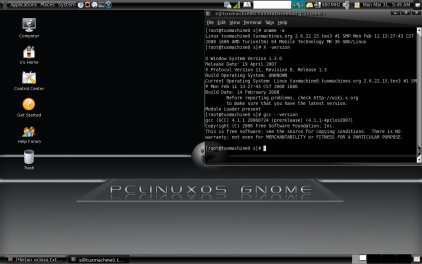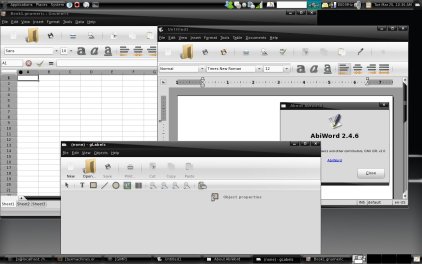Author: Susan Linton
If you’re looking for a GNOME desktop for the popular PCLinuxOS (PCLOS), then newly releasedPCLinuxOS Gnome might be for you.
PCLinuxOS Gnome is a community-developed Linux distribution built on the official PCLinuxOS MiniMe 2008 distribution, which is a minimized system containing the bare-bones necessities for a running system, a skeletal window manager, and a remastering tool. PCLinuxOS itself, known for its ease of use, beauty, and functionality, is loosely based on Mandriva Linux. It retains the RPM package format, ports the Mandriva Control Center and live installer, and focuses primarily upon KDE. It also contains components from Gentoo, openSUSE, Fedora, Debian, and Ubuntu. The distro’s developers tend to adapt the best elements of some of the best distros available for their own distribution. They tweak, customize, and rebuild each package for PCLOS, creating a fast and stable environment.
With GNOME’s user base polling in at between 35% and 45%, this demographic became too large to ignore. GNOME packages were traditionally available to PCLOS users, but they would then run bloated systems due to having both sets of toolkits, libraries, packages, and applications on a system built around KDE and Qt. With PCLinuxOS Gnome, developers can concentrate on eliminating most of the KDE and Qt packages, tweaking the appearance and usability of GNOME, and providing timely updates. In other words, GNOME is the priority, not an afterthought.
Hardware support
I tested PCLinuxOS Gnome on my favorite machine, a Hewlett-Packard Pavilion dv6000, which features an AMD processor, Nvidia chips, a Broadcom wireless Ethernet adapter, and a modest 512MB RAM. Linux usually supports this laptop’s basic hardware fairly well, with the exception of the Broadcom wireless chip.
I did experience a few glitches with the live CD, the first of which occurred during boot. The machine paused during hardware detection and remained paused until I depressed a key, at which time it finished booting. I found this condition with PCLinuxOS 2008 MiniMe as well, but it disappeared after I installed the distro onto the hard drive.
I experienced another glitch concerning network configuration. While configuring my wireless connection, I was given the choice of drivers to use. When I clicked bcmwl5, the system locked up. This didn’t happen in PCLOS or after the hard drive install.
Also, apparently PCLOS, and thus PCLOS Gnome, has some difficulty detecting hard drives or buses. Every module for hard drives is loaded at each live CD and hard drive boot. Although this implementation is a bit uglier than having drivers for specific hardware loaded, it’s better than not supporting certain hard drives at all.
Lastly, the suspend and hibernate modes were inoperative at first boot. I tried installing proprietary graphic drivers, which sometimes fixes the problem in some distros, but I then discovered the solution was to install the suspend-scripts package from the preset repositories in Synaptic. At that point, both suspend and hibernate worked well and were able to restore all open files and the Internet connection.
Other than those little issues, all was well. My desktop was rendered at the optimal 1280×800 screen resolution with perfect proportion and pretty fonts. Sound worked automatically, and the included sound theme was charming. My touchpad operated accurately and responsively without being overly sensitive, and my multimedia keys worked after I changed from the generic keyboard configuration to the HP Pavilion configuration in Preferences. CPU speed scaling worked out of the box, and configuring my wireless Ethernet configuration was easy using the Network & Internet Configuration tool. Inserting removable media opens a Nautilus file browser window or associated application.
All in all, I found good hardware support. With two issues present only when using the live CD, another issue of no real consequence, and another fixed by installing the proper support package, I had little to complain about.
Software and tools
Like PCLOS, PCLinuxOS Gnome comes with a vast amount of software for all the most common computer tasks. From games to programming, these GTK apps seem carefully selected to integrate comfortably within the GNOME 2.21.2 environment.
Fun may not be the main focus of PCLOS Gnome, but with all the games and multimedia applications, it certainly seems to be near the top of the list. Among the 17 games listed in the menu are Blackjack, FreeCell, Gnometris, Mahjong, and Sudoku.
The multimedia menu contains items for all sorts of video and audio enjoyment and manipulation, including AcidRip, Audacity, Banshee, GNOME MPlayer, Me TV, VLC, Brasero, and Serpentine. PCLOS doesn’t ship with the Win32 binary codecs anymore, instead opting for open source alternatives when possible. Despite this, I was able to enjoy a variety of video and audio formats. The included dvdcss library allows you to watch encrypted DVDs.
PCLOS Gnome includes a comprehensive collection of Internet communication applications as well. For Internet browsing, you can choose between Epiphany and Mozilla Firefox 2.0.0.12, while Opera and others are available for install. A full selection of browser plugins is included, but I wasn’t able to watch full-screen Flash video. You can chat using XChat, Pidgin, emesene, and GYache. You can transfer files with gFTP or Deluge BitTorrent, and Thunderbird is included for email. For those with a dial-up connection, there’s GNOME PPP.
Graphic applications include Eye of GNOME, F-Spot, the GIMP, gtkam, and XSane. Gnumeric, gLabels, and AbiWord handle office tasks, and OpenOffice.org is available from PCLOS software repositories.
Synaptic is the face of PCLOS Gnome’s software management system. It’s a graphical front end for APT that PCLOS developers have adapted to install their RPM packages. The repositories are already set up in APT and are loaded with a wide variety of software. Use the search function to find your desired package; if available, Synaptic will download and install it with its dependencies. APT is easy to use and has a low failure rate, making it one of the main advantages to using PCLOS or one of its derivatives.
PCLOS Gnome’s PCLinuxOS Control Center, the main system-wide configuration utility, is adapted from the Mandriva Control Center. From it, you can configure just about any aspect of the system, including the network, Internet, hardware, security, boot, and system. This control center has few rivals in the Linux community.
GNOME also comes with its own control center, which is used primarily for customizing the desktop on a per-user basis. It includes options to set up the appearance of the desktop and determine how to handle audio and video files, screen resolution, screensaver options, cron jobs, and more. Some other features that affect the whole system require root permissions and ask for a password.
Several standalone tools are available in the System Tools menu too, including GConf Cleaner (which can clean redundant or orphaned keys from the GConf database), Make LiveCD (the remaster tool), and Disk Usage Analyzer. Under the hood, the GNU Compiler Collection (GCC) 4.1.1 and X.Org 7.2.0 sit upon Linux 2.6.22.15.
Conclusion
PCLinuxOS Gnome is a fast, stable desktop distro with a professional look and feel. It delivers an attractive GNOME desktop with an understated background, modern theme, and bold color scheme. The fonts are gorgeous, and the menu, applets, and applications are responsive.
Hardware support is good, and the included software seems intuitive. Other than the previously mentioned issues, everything seems to function as desired. The software isn’t bleeding-edge, but it’s stable. The impressive performance makes PCLOS Gnome a pleasure to use.
If you’re a GNOME fan or would like to be, check out this community-developed system for yourself.
Categories:
- PCLinuxOS
- Reviews
- Linux
- Distributions




